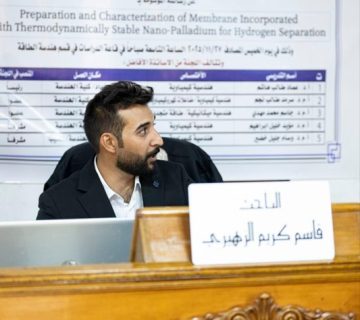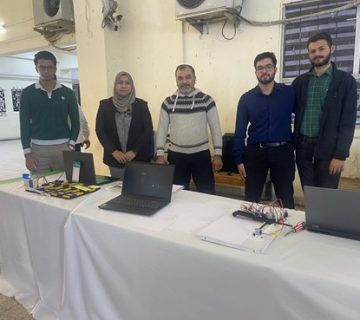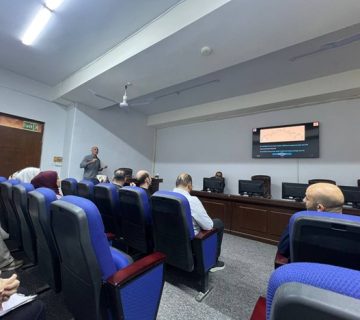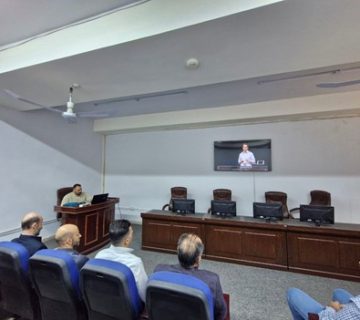The Chemical Engineering Department at the College of Engineering, University of Baghdad, held a Ph.D thesis examination titled:
“
Investigation of Phenol Removal Efficiency from Aqueous Solution by Electrochemical Filtration
“
By the student Enas Ali Anwer and supervised by Prof. Dr. Ibthal Kareem Shaker. The examination committee consisted of Prof. Dr. Hasan Ferhood Makki as Chairman and the membership of Asst. Prof. Dr. Sarmad Talib Najim, Prof. Dr. Rasha Habeb Salman, Asst. Prof. Dr. Atheer Mohamed Ghalib and Asst. Prof. Dr. Shaymaa Abd-Alrahmam Ahmed. After conducting the public discussion and listening to the student’s defense, the thesis was accepted. The thesis was summarized as follows:
In this study, phenol was effectively removed from aqueous solution via electrochemical filtration (ECF) system incorporating with multi-walled carbon nanotube (MWCNTs) filter. The process was conducted in a flow-through system at 1.5 ml/min, and two different supporting electrolytes (NaCl and Na₂SO₄) were investigated to evaluate their influence on removal efficiency and oxidation pathways.
Sonication and vacuum filtration technique have been used for the manufacturing of MWCNTs filter, where Polytetrafluoroethylene (PTFE) membrane has been used as a substrate using dimethyl sulfoxide (DMSO), ethanol (ETOH), and distilled water in the presence of MWCNTs as the dispersing solution. The effect of different operational parameters such as solvent type and volume of filtered solution on the structure, and morphology of MWCNTs deposit film were studied.
The results show that DMSO, ETHO, and distilled water have zeta potentials of-45.54 mV, -19.63 mV, and 9.55 mV respectively. Since DMSO is the highest the zeta potential value, it is the ideal solvent for MWCNTs dispersion and filter preparation. During the morphology analysis of the multi-walled carbon nanotube distribution on the membrane, the dispersion in dimethyl sulfoxide exhibited the most uniform distribution compared to the other solvents.
The prepared filter was assembled in a flow through electrochemical filtration reactor as anode– couples with perforated titanium, and used perforated stainless steel (St.St) as cathode. To optimize operational parameters and assess the influence of variables which are initial phenol concentration (50, and 100 mg/l), Voltage (1, 2, 3and 4 volt), and electrolysis time (10, 30 ,60 and 90 min). Taguchi method was employed as a statistical design of experiments (DOE) approach with L16 orthogonal array) OA) using NaCl (0.6 g/l) as electrolyte solution. Also, with L16 orthogonal array using Na2SO4 (1.42 g/l) as electrolyte solution.
Phenol removal efficiency (PhRE%) was used as performance indicator. In the experiment of NaCl the result of ANOVA and signal to noise S/N Showed that applied voltage was the most influential factor on phenol elimination effectiveness, while the phenol concentration was the least impact. The multiple regression approach was used to obtain the equation characterizing the process, and the projected equation had an (R2) value of 88.59%, and the optimum conditions of PhRE% were with voltage of 3volt, 50 mg/l phenol concentration and time of 90 min with the higher phenol removal efficiency of 90 % and 88.315% for experimental and predicted results, respectively. On the other hand, in the experiments of Na2SO4. the projected equation had an (R2) value of 97.82 %, and the optimum conditions of PhRE% were with voltage of 4volt, and time of 90 min with the higher phenol removal efficiency of 81 % and 88.315% for experimental and predicted results, respectively.
Interestingly, the specific energy consumption (SPC) values based on chemical oxygen demand (COD) for NaCl remained relatively stable with increasing voltage, ranging between 2–3.5 kWh/kg, suggesting that efficient oxidation occurs even under milder conditions. On the other hand, Na₂SO₄ showed a steady decline in SPC with increasing voltage, dropping from about 9 kWh/kg at 1 volts to around 4 kWh/kg at 4 volts. This indicates that higher voltages enhance the generation of hydroxyl radicals, thereby improving degradation efficiency.
Results showed that the type of electrolyte had a significant impact. NaCl provided the highest phenol degradation efficiency mainly due to the formation of hypochlorous acid (HOCl), a strong oxidizing agent produced during electrolysis in chloride-containing solutions. On the other hand, Na₂SO₄, which sulfate radicals (SO₄•⁻) , species, showed lower removal rates but offered more stable operation with less risk of forming harmful byproducts.








